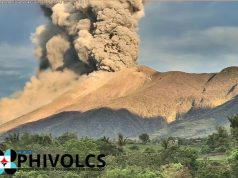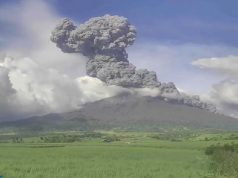The undersecretary of the Philippine Institute of Volcanology and Seismology did not immediately agree with the suggestion of Sen. Tito Sotto III that cloud seeding should be done in areas affected with Taal Volcano’s ashfall.
Phivolcs Director Renato Solidum said that further study must be done about operationalizing the weather modification activity.
While it may help plants covered in ashfall, it might also bring threats of lahar and flooding in areas near the volcano.
“You have to study how to operationalize cloud seeding,” Solidum said in an interview with CNN Philippines.
He added in a press conference that initiating the activity is difficult if there are no clouds available for seeding in the first place.
“Mahirap mag-cloud seed kung walang cloud na isi-seed mo para umulan,” Solidum said, as quoted by reports.
“Pero kung gaanong kalaking ulan ang mapo-produce n’yan at kung saan tatama ‘yung ulan, obviously, dapat meron kang ideal condition na ika-cloud seed mo,” he added.
Solidum also emphasized that rains might trigger flash floods and lahar.
“Well, this has to be studied. Kung titignan mabuti, obviously, kung masyado maraming tubig, e mawa-wash down ‘yung abo sa gilid, at may banta ng flood or lahar dahil wina-wash down ‘yung mga abo,” he said.
Phivolcs defined lahar as “slurries of volcanic sediment, debris and water that cascade down a volcano’s slopes through rivers and channels.”
It is sometimes called volcanic mudflows or debris flows, the agency added.
Lahar is “mainly generated by torrential rainfall on unconsolidated deposits from a past eruption,” Phivolcs said.
Sotto previously said that cloud seeding should be done in the areas affected by the ashfall brought by the heightened unrest of the Taal Volcano.
“I’m proposing cloud seeding action in the Taal Volcano affected areas and not wait for the rain. I sent word to the executive dept through Bong Go and ES (Executive Secretary) Medialdia. Water solves the ashfall debris,” he said to ABS-CBN.
Sotto also tweeted the same idea on his social media account prior.

Many Filipinos disagreed with his suggestion, including a student of Geography from the University of the Philippines-Diliman and a licensed professional teacher.
Jael Gonzales, an undergraduate student, pointed out that cloud seeding is not “instantaneous” in itself.
“Cloud seeding is not instantaneous, any clouds would be blown in the same direction as the debris and gases that came from Taal. Mixed with water, they will produce acid rain and runoff,” he said.
Twitter user @ejgp0627, a licensed teacher, recalled the 1991 eruption of Mt. Pinatubo when heavy rains produced lahar that “destroyed the homes of more than 100,000 people in the area surrounding Pinatubo,” according to the United States Geological Survey.
OMG, Tito Sotto strikes again with a minefield of problematic statements:
1. Cloud seeding = Acid rain / Lahar (remember Pinatubo '91?)
2. Cloud seeding on a no-fly zone?
3. Isn't it Bong Go's already part of the Legislative Dep't? Oh yeah, a seven-hour glitch senator 🙄 https://t.co/hYSG86TWt0
— The Earl of St. Peters (@ejgp0627) January 13, 2020
USGS also noted that the lahar also caused “more devastation in the (surrounding) lowlands than the eruption itself.”
“In the next four rainy seasons, lahars carried about half of the deposits off the volcano, causing even more destruction in the lowlands than the eruption itself,” the website said.
The Twitter user also pointed out that the vicinity around Taal Volcano, particularly within the 14-kilometer radius from the crater, is considered a “no-fly zone” because of the ash and smoke being emitted.
It could be recalled that the Ninoy Aquino International Airport canceled all of the flights on January 12, Sunday due to the steam-driven eruption where plumes rose as high as 100 meters.
For cloud seeding to be enacted, planes must be deployed in the airspace where clouds are present.
Elmer Caringal, a hydrologist from the Philippine Atmospheric, Geophysical and Astronomical Services Administration, previously said that it could only work if there are “thunderstorm clouds” in the sky.
How does cloud seeding work?
Cloud seeding is the process of adding chemicals, particularly silver iodide or dry ice, to clouds through airplane flares in order to increase rainfall.
It is usually done by the Bureau of Soils and Water Management — an agency under the Agriculture Department — to help areas suffering from drought or dams and reservoirs with low water levels, according to an ABS-CBN News report.
“Cloud seeding works by deliberately sodium chloride or salt into clouds with high moisture content. These are what we call seedable clouds. Once the salt is introduced into the clouds, water vapor attaches to it,” it said.
“They become ice crystals and become bigger. When the cloud can no longer hold on to this, it falls and becomes rain,” the report continued.
It noted that rainfall will begin to commence 30 minutes to one hour after a successful operation.
However, not all clouds can produce sufficient rainfall, PAGASA assistant weather services chief Charmie Monteverde said.
Engineer Teresita Sandoval, chief of BSWM’s water resources management division, revealed that cloud seeding is not an instantaneous process that can be done for the sake of doing it.
“Pupuntahan po nating lahat ‘yung munisipyo, tatangungin natin ‘yung mga technician doon, ‘Ano bang nakatanim? Ano ba ‘yung affected ng cloud seeding? Ano ba ‘yung affected ng drought?’ Kapag sinabi po nila na sampung hektarya lang, hindi naman siguro tama na mag-cloud seeding,” she said.
“Kailangan po natin, andun po sa ating guidelines, kailangan at least 1,000 hectares po ‘yung affected area. At meron po dapat na standing crops… na i-sa-save for total loss,” Sandoval continued.










